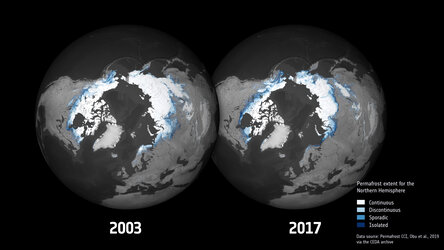
Applications
Permafrost extent 2003-2017
This animation shows the permafrost extent in the northern hemisphere from 2003 to 2017. The maps, produced by ESA’s Climate Change Initiative, are providing new insights into thawing permafrost in the Arctic. Continuous permafrost is defined as a continuous area with frozen material beneath the land surface, except for large bodies of water. None-continuous permafrost is broken up into separate areas and can either be discontinuous, isolated or sporadic. It is considered isolated if less than 10% of the surface has permafrost below, while sporadic means 10%-50% of the surface has permafrost below, while discontinuous is considered 50%-90%.






